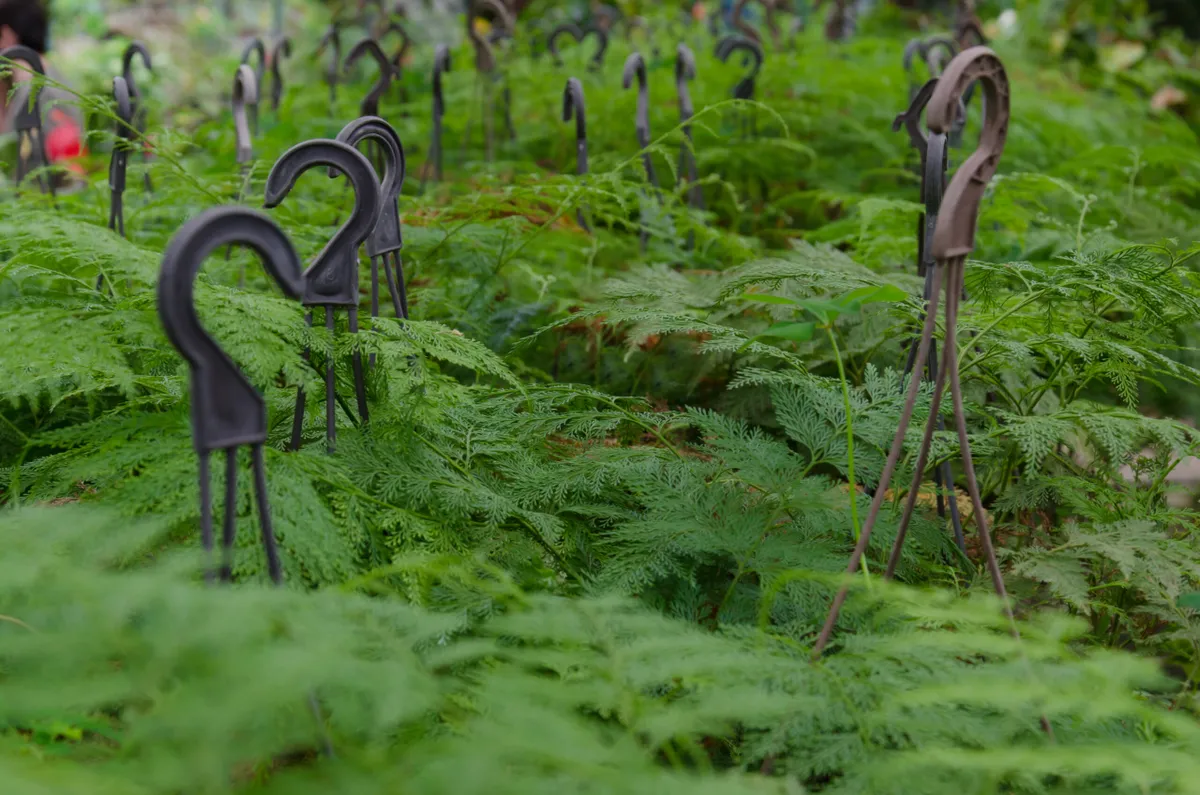Pothos pushing under net curtains; red pelargoniums blazing from behind a misted window; palm fronds tapping against glass – I love spotting houseplants. Hairdressers’ windows are a good place to find them. Perhaps it’s the warm fug fostered by hair dryers, but plants seem to thrive in salons. My own hairdresser has just one plant, but it’s a beauty – an asparagus fern that trails from the top of a cupboard near an east-facing window.
Jump to
- How to care for asparagus fern
- Cutting back asparagus fern
- Propagating asparagus fern
- How to water asparagus fern
- Where to put your asparagus fern
- More on asparagus ferns
How to care for asparagus fern
Cutting back asparagus fern
Follow my hairdresser’s lead and give your asparagus fern a quick trim with a pair of scissors if it starts to get out of bounds.
How to propagate asparagus fern
Late winter or early spring is a good time to tackle this task. First, give the plant a good soak in water for an hour. Then, wearing thick gloves to protect from thorns, work an old palette knife around the edge of the pot to loosen the rootball (many a terracotta pot has been smashed as a result of an asparagus fern set like concrete into it). Once the rootball is dislodged, start teasing away at the chunky, white root tubers, separating the plant into equal portions, each with a decent set of roots and foliage. Pot up the asparagus fern individually into houseplant compost with a handful of grit or perlite for added drainage.
You may also like
- How to grow the house plant Peperomia
- The rise and rise of the house plant
- Houseplant ferns: how to look after Phlebodium aureum
- Are you a closet pteridomaniac?
- How to care for ferns and the best for your garden
Here's more on propagating ferns

How to water asparagus fern
Although asparagus ferns may shed their needle-like foliage with abandon if the compost is allowed to dry out too much, or when they are situated somewhere too dry and hot.
Here's golden rules on watering house plants
Where to put your asparagus fern
When choosing an asparagus fern, it’s important to consider how these plants like to grow. Some species are born to climb. In a garden centre recently, I spotted a lovely specimen of the ubiquitous Asparagus setaceus, the common asparagus fern. At 1m tall it was living its best life, sending out bare, wiry stems to wrap around its pole, before clothing those stems in feathery foliage. Nearby, pots of asparagus smilax (Asparagus asparagoides) look set to burst the bounds of their tiny trellises and colonise the whole shop. Other asparagus fern forms suit hanging or trailing. My hairdresser’s plant, Sprenger’s asparagus (Asparagus aethiopicus), looks best as a waterfall of wiry stems cascading from a hanging basket, while the foxtail fern (Asparagus densiflorus ‘Myersii’), has plume-like stems and a bushy habit that looks stunning on a plant stand.
One downside is that asparagus ferns have thorns that can scratch mercilessly when repotting, and the thorniest of all asparagus ferns is the sicklethorn (Asparagus falcatus).
The best pot for an asparagus fern
A heavy, terracotta pot has two advantages when it comes to an asparagus fern: those ferns with a trailing habit are less likely to topple, and plants are not prone to succumb to yellowing fronds owing to overwatering, as excess water can evaporate away through the porous pot. When it comes to dividing, however, plants in clay pots can prove a challenge.

More on asparagus ferns
Is asparagus fern a real fern?
Despite fern-like, frothy foliage, an asparagus fern is not a bona fide fern: asparagus ferns are part of the genus asparagus and cousin of the much-prized vegetable (Asparagus officinalis). If you struggle to grow true ferns, try an asparagus fern. These ferns are invaluable if you find yourself unable to meet the care requirements of, say, a maidenhair fern, whose precise approach to soil moisture (not too wet, not too dry) can test the most attentive grower.
Asparagus ferns’ refusal to wilt, along with their wiry tenacity, has long made them a hit with florists. Celebrity florist Simon Lycett has an office full of photographs of brides past and present holding bouquets with clouds of asparagus ferns. “It’s been a real stalwart of florists ever since we started arranging, certainly from Victorian times,” he says.
Where do asparagus ferns originally come from?
The half-dozen or so species that make up the asparagus ferns commonly raised as houseplants hail from southern Africa, where they grow as understorey plants in dappled light. The tuberous roots that store energy and water to carry the asparagus fern through lean times in the wild make these ferns tolerant of the occasionally aberrant watering regime of the average indoor gardener. Another curious feature is the tiny, scale-like structures on the stems of an asparagus fern: what we assume to be leaves are in fact cladodes, which are flattened stems that can photosynthesise.